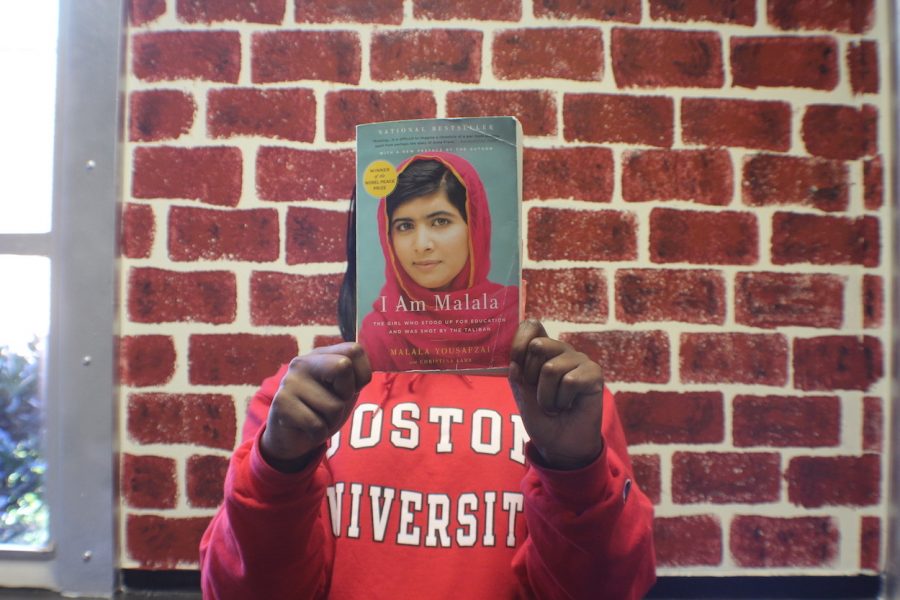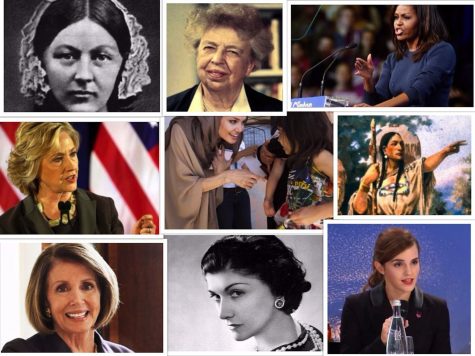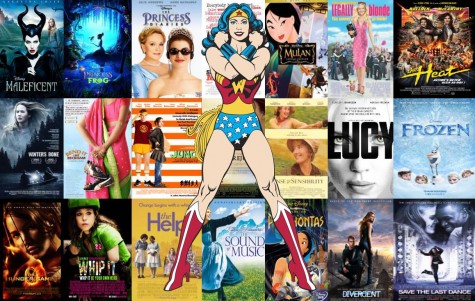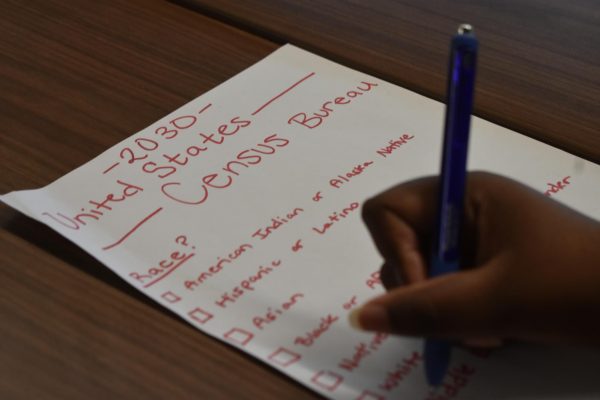A trip through “herstory”: The Chant explores eight bold women of history
Senior Kesha Perkins stands firmly, masking herself as Malala Yousafzai. “Malala embodies the spirit of feminism and universal education. Her willingness to stand up against the biased education system is an inspiration to all females, even me who has access to education,” she said. Malala inspires people across the globe to provide equal opportunity to both sexes.
March 8, 2017
Today the world “celebrates the social, economic, cultural and political achievement of women” during International Women’s Day (IWD). Each year, IWD creates a new theme, and they announced that this year would commemorate #BeBoldForChange. To honor this special event, The Chant compiled a list of the the boldest women in history… or rather, herstory!
Hatshepsut
Born in Egypt during the 16th century BCE, Hatshepsut lived in one of the most forward ancient empires. Egyptians considered happiness as a goal to achieve in life, and women enjoyed many liberties that others in their time period did not possess. However, men made up the majority of pharaohs throughout Egyptian history, but Hatshepsut changed people’s’ perception on female rulers and made the rise of Cleopatra a possible reality.
“What Hatshepsut does is she recognizes that power is tied to gender in Egypt, and because the Egyptian understanding of power was that power what inherently male, she needed to perform a male gender in order to be legitimate,” AP Comparative and Art History teacher Carolyn Galloway said. “One thing that I think is really import is that we have power structures that are so normalized that we don’t even think about. It’s called hegemonic control.”
After her husband Thutmose II’s death, the throne passed down to his two year old son, Thutmose III. Hatshepsut acted as regent pharaoh for her stepson, but in her seventh year of ruling, she crowned herself pharaoh with full power, defying Egyptian tradition. Despite taking feminine titles, Hatshepsut dressed as a man throughout her reign which historians believe she did to display her opinion on traditional gender roles common in the New Kingdom and assert her authority. Even statues and texts depicted her as a man!
Hatshepsut ruled for 21 years, 1479–1458 BCE, making her the longest reigning female pharaoh. During her time on the throne, Hatshepsut focused on domestic matters rather than conquering new territory. Hatshepsut concerned herself with improving the economic prosperity and cultural architecture of her kingdom. She sent out an expedition to Punt which brought back treasures such as gold and ivory, and she ordered the construction of new temples and obelisks to revitalize existing monuments.
Theodora
Growing up in a hippodrome (circus), Theodora’s early life provides few answers. Historians know that her father trained bears and her mother danced and acted on stage, but following the death of her father, Theodora enlisted herself into brothel in Constantinople. Later, she would work as a wool spinner and actress when she met Justinian. He immediately fell in love with her wit and beauty and wanted to marry her, but according to Roman law, a high ranking official could not marry an actress. However, Justinian pushed for a repeal on the code and married his beloved in 525 CE.
Two years later, the crown fell upon Justinian I’s head, and the Eastern Roman (Byzantine) Empire named Theodora augusta (empress). She did not rule the empire alongside her husband, but he trusted her opinions just like his advisors. Through this respect, Theodora influenced Byzantium’s affairs considerably. Belonging to a Christian minority group called the Monophysites in the majority Orthodox Christian empire, Theodora fought for equality among religious denominations and even ended the persecution of the Monophysites in 533 CE. Furthermore, Theodora enacted legislation criminalizing the trafficking of young girls and providing more property rights for women dealing with divorces. She even communicated with foreign rulers, a job deemed only fit for emperors, and appeared in numerous legal codes passed during her time on the throne.
Theodora’s rule began in 527 CE and ended after her death in 548 CE. Despite his devastation over the loss of his wife, Justinian I continued to fight for unity among religious groups, proving her lasting impact.
Joan of Arc
Born during the Hundred Year’s War between France and Britain, Joan of Arc lived in Domrémy, France with her tenant-farmer family. She received visions from Michael the Archangel and The Great Martyr Saint Catherine calling her to lead a pious life and designating her as the savior of France. English king Henry VI, French king Charles VII, and Phillip III, Duke of Burgundy, all laid claim to French territory, but Joan of Arc, determined to restore order, secured a position in Charles VII’s army.
Joan of Arc traveled to Orléans, preparing for battles in the stalemate situation. She led battles and fought against the English who retreated after three days of attacks in May of 1429. After the recapture of Orléans, France coronated Charles VII its king. She continued to defeat the English in battles, nine out of 13, but as few as 30 towns surrendered without a fight. However, when Joan attempted to free the city of Compiègne from its captors, the Burgundians outflanked her troops and they retreated, but Joan stayed behind to ensure every one of her men left safely. The Burgundians captured Joan of Arc after she gave herself up. News of her capture reached Paris, and the Bishop of Beauvais demanded her transfer for a trial.
During the trial in 1431, Joan of Arc received charges of blasphemy regarding her claims to divine revelation, endorsement of Jesus and Mary in written letters, assurance for salvation, ability to predict the future, attempted suicide when trying to escape, and masculine attire. Found guilty of heresy and sorcery, she burned at the stake at the age of 19. Pope Callixtus III performed a posthumous retrial ending in 1456 that found Joan of Arc innocent of the accused charges. Pope Benedict XV canonized her Saint Joan of Arc, a martyr and patron saint of soldiers and Orléans.
Catherine the Great
At the age of 14, Sophie Friederike Auguste von Anhalt-Zerbst, a minor German princess, left her home in Prussia to marry grand duke Karl Ulrich, who later became Peter III. She took the title of grand duchess (princess) Catherine II under the reign of Empress Elizabeth who stabilized the Russian empire. Catherine’s husband, native to Prussia, disliked Russia despite his standing as heir to the throne after Elizabeth; he also acted neurotic and suffered from alcoholism.
Following the death of Elizabeth I in 1761 during the Seven Year’s War against Prussia, Peter III filled the vacancy of the throne even though the Russian people detested and clearly preferred Catherine who held herself in a higher regard with her intelligence and charm. Peter III ended the war and crafted an alliance with their enemy, the last straw for the Russian people. The army, who supported Catherine, led by her lover, Grigory Orlov, forced Peter III to abdicate the throne, and they executed him eight days later.
Catherine the Great, dedicated to her new country, intended to expand the education system, better the economy, and create a powerful state with a strong national identities that reflected French culture. After Elizabeth I’s death, the treasury of Russia laid empty, and Catherine managed to refill it by nationalizing property of the clergy which incorporated approximately 33 percent of Russian land. She also utilized government spending to build new school, especially for women, and cultural structures like theatres. Furthermore, she extend Russian territory through her general military success.
Mary Wollstonecraft
Born in London in 1759, Mary Wollstonecraft moved around during her youth due to her father’s lack of economic responsibility. Mary grew up with an abusive father and left the family early in her life to work as a teacher and governess. The experience that she gained during these jobs led her to write Thoughts on the Education of Daughters in 1788. Mary discovered she did not enjoy domestic life and moved back to London to work in a publication office with the liberal writer James Johnson. When he created the publication Analytical Review in 1788, Wollstone became a regular contributor to the paper.
In 1792, Mary Wollstonecraft wrote her most famous piece of work, A Vindication of the Rights of Woman, in which she argued for equal opportunity for education and work among men and women. Her writing used rational approaches popular during the time period, and she impressed male readers with her ability to write a thorough argument. Mary Wollstonecraft received recognition for writing one of the foundation works of the feminist movement.
Harriet Tubman
Life for Harriet Tubman never seemed remotely easy or even fair. Born to a family forcibly under slavery, she lived in a plantation in Maryland where the owner’s son sold three of her sister, fragmenting the family. After attempting to sell Tubman’s youngest brother, her mother put her foot down which inspired the youthful Tubman. She faced harsh conditions at the plantations, often receiving physical punishment that left scars and injuries for the rest of her life. Despite her father becoming a free man after the death of his owner, Harriet Tubman did not receive her freedom.
“Historically, blacks have had to succumb to the oppression of the systematic racism that they face as a culture, from literacy tests just to vote to segregation of schools,” senior Celina Cotton said. “Black people have never really been granted the same opportunities as white people in this country. I feel as though this illusion that just because civil rights has ended and on paper we are equal, there are still several elements of systemic racism and oppression everywhere we look. Harriet Tubman inspires me as a woman of color because she faced life threatening odds, look past the danger, and simply did what she knew was right. She challenged the system and found a way to break it.”
In 1849, Tubman escaped slavery and fled to Philadelphia using the 90 miles of trails in the Underground Railroad. She would return to the South 19 times to help approximately 300 slaves escape and led them to the Free States in the North, but after passing the Fugitive Slave Law, Tubman rerouted the Underground Railroad to Canada. And when the Civil War began in 1861, she nursed and cooked for the soldiers of the Union Army until they asked her to act as an armed scout, the first woman to lead an armed expedition against the Confederacy, and spy.
Indira Gandhi
With no relation to Mahatma Gandhi, Indira served as the first woman prime minister in India. Her father, Jawaharlal Nehru, held the office of prime minister, first in the newly independent India, which incited Indira’s passion for politics. In 1955, Gandhi joined the Indian Congress Party made popular by her father and rose through the ranks.
In 1966, Indira Gandhi filled the role of prime minister after the sudden death of Lal Bahadur Shastri. Right-wing members of the party did not favor her, but Gandhi formed a new faction within the Congress Party that backed her. Indira impressed her country and proved her ability to lead after a swift victory against Pakistan which stemmed from territorial disputes. She further improved India with her policies that invited the Green Revolution into the country, using high-yield seeds and improving irrigation to create a surplus of grains that would feed the food shortages. Gandhi also introduced program that improved the dairy industry in India, the White Revolution, allowing the country to rely solely on itself for food. Additionally, Indira pushed India into the Nuclear Age by developing nuclear technology so that her country could compete with or defend themselves from international superpowers.
India’s multitude of cultures plagued the nation with conflicts in the 1980s despite Indira Gandhi’s attempts to unify the country. Secessionist movements became popular, especially in the Punjab region where a group of separatist Sikhs occupied a holy shrine, the Golden Temple, and Gandhi ordered military action to end the conflict. Nearly 450 Sikhs died as a result of her orders, and two of her Sikh bodyguards assassinated her in 1984. Despite her tragic death, she governed India for 15 years, the second longest-running prime minister after her father.
Malala Yousafzai
Born in Pakistan in 1997, Malala’s family put a great emphasis on education, especially her father who taught for a living. She loved going to school, learning, and competing for first-in-class. However, by the age of ten, the Taliban began to control Northern Pakistan where her home, the Swat Valley, resided. One of the terror group’s key arguments included forbidding girls to attend school, and within a year, the Taliban destroyed 400 schools.
“Everyone should have access to education and a person’s gender should not determine his or her eligibility,” senior Kesha Perkins said. “Educating females gives them a sense of empowerment and helps make much-needed room in a male-dominated society; females have the same intellectual abilities as their male counterparts. Malala embodies the spirit of feminism and universal education. She proves that females work just as hard as men and value their education just as much. Her willingness to stand up against the biased education system is an inspiration to all females, even me who has access to education.”
Obviously, Malala did not approve of the terror group taking her basic human right to an education, so she quickly started to speak out about the injustice she and other Pakistanis faced. On TV programs and a BBC blog, Malala condemned the Taliban for their hypocritical stance on schooling and twisting of Islam to justify their oppressive nature. Soon, her town became a warzone with frequent suicide bombings and gunshots, and Malala feared for her life and the safety of her family after the Taliban put a bounty on her head.
In October 2012, while Malala drove home in a bus with her friends, a Taliban gunman shot her in the head for speaking out against the fundamentalist group. After surgery and doctors placing her in a medically-induced coma, Malala woke up in Birmingham, UK where she continued her fight for universal education. In 2013, she spoke at the United Nations about the vitality of educating all women and released her autobiography I Am Malala: The Girl Who Stood Up for Education and Was Shot by the Taliban. Malala received the Nobel Peace Prize in 2014 for her humanitarian efforts to expand universal education to countries across the globe.
Global Women Now
“I don’t feel as though women are equal to the privileges men are simply handed,” actress Emma Watson said. “Women are classified as bossy, arrogant, even rude for having the same opinion a man would. Women are criticized for daring to ask for equal pay. In the business world, women must exude more confidence and come off stronger just to be heard and her opinions respected. I do think the movement HeforShe has encouraged not only female feminists to speak up about equality for genders, but also for males to realize that feminism is not a bad word. It isn’t something that we should look down on as a society.”
Feminists like Watson set a global example of a woman who use their voice, status, and strength to exemplify the true meaning of equality of the genders.
While the world honors International Women’s Day, it must not only celebrate women’s achievements but also realize that inequality and discrimination still stunt women all over the world from achieving their complete potential.























